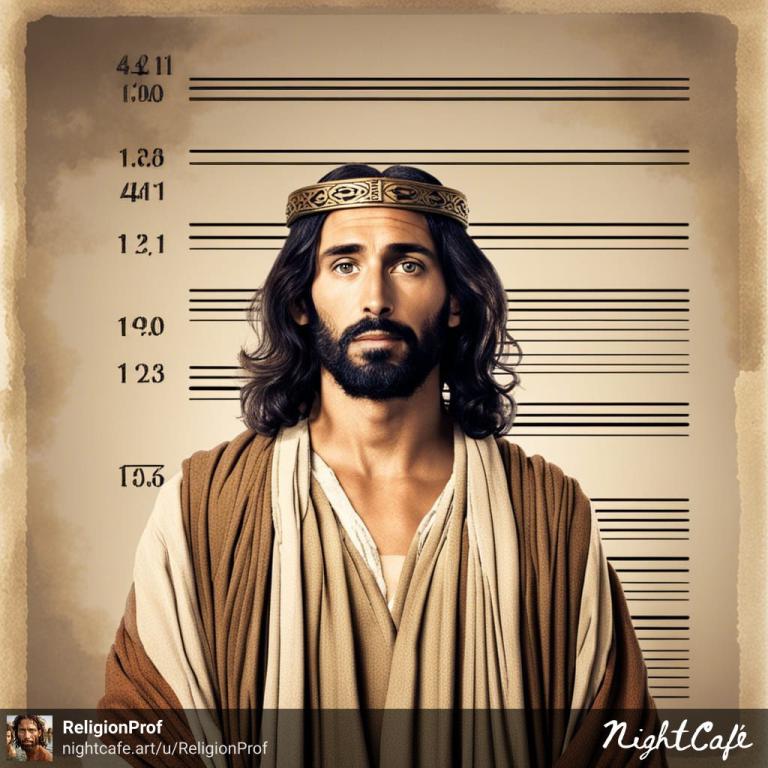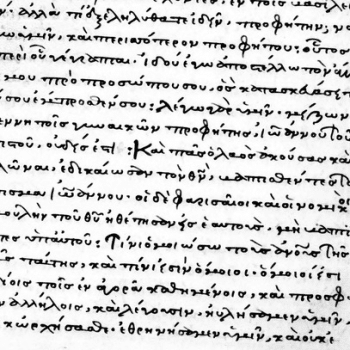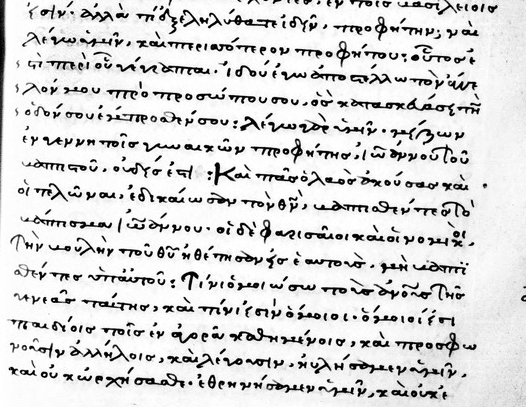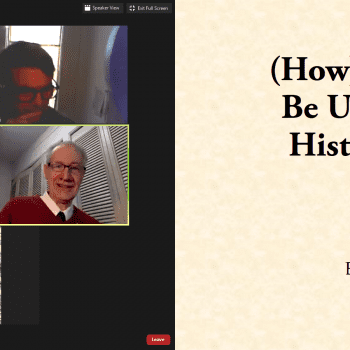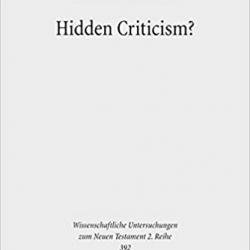These are my notes from and thoughts about the second day of the Enoch Seminar conference on John the Baptist. Enoch Seminar meetings tend to begin with a recap session each subsequent day. They provide a helpful opportunity to remind ourselves about things that were said and to draw attention to points that were felt to be significant. For me, one particularly significant point was the highlighting of the puzzling idea that John could be Elijah and that Jesus could be John or one of the prophets from Israel’s history, and the possibility that this might have something to do with the idea in mystical traditions that one might have a celestial Doppelganger or counterpart.
Gabriele Boccaccini started things off by restating questions that we covered yesterday, which can be summarized thus: how important are Jewish and Christian sources for the understanding of the historical John? He mentioned my blog post summing up the first day.
Joan Taylor was not present yet due to the time difference between the United States and New Zealand, but sent a message with some thoughts. She highlighted the way any missing piece of evidence changes the picture, and also emphasized that Josephus’ testimony appears to be independent of the Gospels. One result of having the conference online is that the global attendance has been improved. Scholars from parts of the world that are underrepresented when travel is necessary. We had some 120 present on Zoom and thousands who viewed the introduction session livestreamed on Facebook.
Al Baumgarten asked what we know with the highest degree of certainty, and what happens if we start with those things. He also asked whether John is special with the evidence being worse than for other historical figures, and if so how and why. Joel Marcuss emphasized that we have more to work with in the case of Jesus. John and Jesus are similar to one another (and to Socrates) in that they did not leave us writings of their own. As for what is most certain, Marcus suggested: that John baptized Jesus, that he was executed by Antipas, and of course his water rite. Boccaccini emphasized the importance of stating another thing that we know for certain–that John was a Jew–but also the importance of asking what kind of Jew John was since second temple Judaism was diverse. Larry Schiffman suggested that Jesus must be placed in the framework of common Judaism, including things like attending synagogue. He also said that we don’t know whether there was a “Baptist sect of John” although positing that may help explain some things and some groups we see later. When Schiffman made reference to the recent events in Washington DC it led me to wonder whether John or Jesus created or shared things that we might categorize as “conspiracy theories.”
Edmondo Lupieri said that a difference is that we have texts from Jesus’ followers but not, apparently, directly from followers of John. He also emphasized that we are all looking at the same evidence and yet draw different conclusions because we have different minds and different assumptions. The same would of course have been true in the time of John and Jesus. Johannes Tromp said that we do not know much more than these four things: he existed, baptized, was executed, and called people to change their ways. Eric Noffke suggested that apocalypticism could also be added to the list. Federico Adinolfi picked up Steve Mason’s point that John was known as “the Drencher” but was really about justice. He also highlighted Daniele Minisini’s point that apocalypticism is less certain than we often assume, this perhaps all stemming from one source, Q, and subsequent writing that knew it. He also raised the matter of the Enochic matrix of John. Enoch has an interest in justice but not in Torah or ritual purity. Thus Adinolfi suggests that, even while most likely not having been an Essene, he was closer to them and their combination of Enochic emphases with purity concerns. Rafael Rodriguez said he is shocked that anyone would say we know much about John, given how little there is in all the sources available to us. Do those provide us with enough to conclude what was important to John? Whatever we think we know, we have to keep coming back to the fact that we do not know very much. How long was his ministry? Where did he carry it out? How old was he? Even when it comes to John and Antipas, Josephus provides a different slant that does not focus on Antipas’ marriage. Steve Mason returned to Baumgarten’s question, asking about historical methods and what is possible. He used the example of failing to understand his own teenage children even when they lived in the same house with him. Who is the historical anyone? What does it mean for a human being to be captured historically? History does not give us a divine omniscient perspective on anyone, much less a figure about whom our sources tell us so little. We should thus recognize that it is the exploration and discussion by historians that we should focus on and value, recognizing that an alleged certain foundation is not a legitimate pursuit. Claude Cohen-Matlofsky suggested that we should seek John’s halakhah, his teaching and interpretation of Torah, as likely to help us make progress. Because Josephus’ John is not Christian, that helps since he is independent of Christian efforts to make John into a Christian and a forerunner. We also need to relate what Josephus says about John to what he says about ritual washing and related matters more generally. Gabriele Boccaccini suggested that halakhic and eschatological elements were present throughout Judaism, albeit with distinctive emphases. There was no non-halakhic Judaism, one that had no interest in matters of ethics and judgment. An interesting question is whether that is compatible with John being an Enochic Jew, since the Enochic tradition does not focus on Torah. Daniele Minisini suggested that Jubilees might give us a sense of how apocalyptic and halakhic concerns could sometimes coexist and relate to one another. Paul Anderson suggested that we know John had a high degree of appeal, which should lead us to ask why. I thought this was a great point! Gabriele Boccaccini clarified that he considers Enochic Judaism not to have a direct halakhic engagement with Torah, because they believed that the problem of evil could not be resolved through Torah. Al Baumgarten mentioned his experience of writing a biography of a modern figure. As he said in that book, we are not just narrators of the lives of figures. We are authors. If we work with Legos, for ancient figures we do not have a full picture from the box nor a full set of pieces. We try to assemble them into something that at least convinces us, relating them to the ancient context. Thus we construct so many different portraits.
He was referring to the introduction of his biography of Elias Bickerman in which he wrote:”L’art du biographe consiste justement dans le choix…De patients démiurges ont assemblé pour le biographe des idées, des mouvements de physionomie, des événements. Leur œuvre se trouve dans les chroniques, les mémoires, les correspondances et les scolies. Au milieu de cette grossière réunion le biographe trie de quoi composer une forme qui ne ressemble à aucune autre.” He translated this in the chat as follows: ” The essence of the biographer’s craft is making choices. The biographer’s industrious assistants have collected ideas, physical characteristics, and events. Their work is found in chronicles, memoirs, correspondence, and commentaries. From among this rough collection of materials, the biographer picks the sources on the basis of which to draw a figure that is absolutely unique.”
In the next session (in which I also presented) Giovanni Bazzana started us off, looking at the Pseudo-Clementine literature. Two recent studies have drawn attention to key questions about history and ritual in this literature. Bazzana offered a visual diagram of how he understands the development of the Pseudo-Clementine literary tradition. The Pseudo-Clementine Recognitions features disciples of John who claim that he is the Christ rather than Jesus. The Homilies make John a member of the “daily baptists” (hemerobaptists). Dositheus and Simon are said to have been heretics who emerged from among John’s followers. He explained how the Pseudo-Clementine literature views history as a series of syzygys, pairs in which an evil figure appears followed by a good one who challenges and corrects them. Bazzana argued that this idea comes from the Grundschrift which the Recognitions and Homilies used as a source. In the Testimony of Truth from Nag Hammadi, studied by Edmondo Lupieri and Pamela Reeves, relates to this tradition. Note that John is said to be a daily baptizer, making him more like the Mandaeans as well as those who engaged in Jewish ritual washing, and less like what became Christian baptism. We need to update our project, taking into account the breadth of evidentiary base as well as ideological blind spots previously neglected.
Alberto Camplani presented next on John the Baptist in Gnostic texts and Marcion. He also brought Manichaeism into the picture, where John the Baptist appears and is viewed negatively. I was intrigued by the use of the term “miscarriage” in a Turfan fragment in Middle Persian, since a pun on a term for miscarriage is used in Mandaean sources, since the Mandaic word sounds like their words for “Jews” and “Judaism.” Marcion’s Gospel seems to have lacked not only the birth narratives from Luke but also other opening events prior to his move to Capernaum (Judith Lieu, Marcion and the Making of a Heretic, p.197). This raises the possibility of an early Christian tradition that did not connect John and Jesus or feature the latter being baptized by the former.
I obviously don’t take notes during my own talk, which you can read on the Enoch Seminar website, except in relation to discussion and feedback afterwards. My main aim was to make a case that the Mandaean sources are worth focusing attention on by those interested in the historical John the Baptist. The harvest of insights is plentiful but the laborers are few. Even if some or many of the avenues that have yet to be studied prove to be dead ends, we will not know unless the studies are done. In the same way that we understand Jesus better as a result even of misguided avenues of pursuit from the past, the same will undoubtedly prove true in the case of the study of the Mandaeans.
Caroline Lemmens presented next about John the Baptist in Islam, beginning with the Qur’an (suras 3, 19, and 21 being the most important). She also brought in Christian sources such as John of Damascus and his De Haeresibus. That work claims that Muhammad “chanced upon the Old and New Testaments” and created a false teaching from it. In the Qur’an Zechariah takes the initiative in seeking a child, rather than as happens in Luke. Zechariah’s inability to speak is a sign not a punishment. These are prophets who are fully human and not divine. The name Yahya (John) is said never to have been given to anyone before, although some interpreters have tried to interpret that as a statement that no one of that name has been given this level of distinction before. Lemmens mentioned the presence of the name Yahya in Mandaean sources, often in a double Arabic and Mandaic/Aramaic form Yahya-Yuhanna. A hadith says that Jesus recognized John’s superiority, although each tried in that tradition to defer to the other. Baptism does not appear. Bishop John of Marde in the 12th century is said to have issued a canon to baptize Muslim children only with the “baptism of John” using “normal water.” They also have a story of John’s talking head.
Pamela Reaves served as respondent to get the discussion started. Her work has focused on John in Nag Hammadi texts. Key threads ran through the papers, such as the polemical reworking of earlier tradition. Reaves turned to my paper and Bazzana’s with out focus on matters of historicity. The ways they revise and rewrite does not necessarily make them not useful for historians, but it does make using them more complicated. Reaves appreciated my case for how Nag Hammadi texts might be historically useful, but also pointed out that the presence of Jewish scriptures does not necessarily cause embarrassment for Gnostics who tended to believe that those sources did indeed provide useful information if interpreted correctly.
John Kampen asked about how Mandaean sources and rituals relate to the Qumran texts and Essenes. That is a topic that is worthy of significant investigation. It hasn’t received the attention it needs, just like most matters related to the Mandaeans.
Edmondo Lupieri also participated in the discussion, noting the connection between the Pseudo-Clementine idea of syzygys and his point about the John-Jesus polarizing interaction. He emphasized the dichotomizing Christology that separated the divine/heavenly Christ from the earthly Jesus, as possibly related to the positive lightworld figures but negative Jesus in Mandaean sources.
Kampen asked whether in the Gnostic and Mandaean sources we see the continuing history of Jewish sectarianism, and is it related to John the Baptist. Boccaccini asked about how the evidence in this session relates to the question of ongoing groups with competing allegiance to John and Jesus. Marcus asked about the Ps-Clem Grundshrift and its negativity about John, and how that relates to the question of that tradition being in contact with followers of John. Bazzana and Camplani shared some responses, the latter pointing out the fact that some Gnostic sources take a negative view of baptism.
I mentioned the way Theodore bar Koni refers to the Mandaeans as Dostheans, i.e. Dositheans. The key question is how Gnostic ideas relate to Jewish sectarian ideas from the second temple period. There seems to be at the very least a close relationship to apocalypticism, but it solves the problem of evil by making the world not merely a place ruled over by evil forces at odds with the supreme God, but created by those evil forces. The question is when that idea first finds articulation in that form, and which comes first. Is apocalypticism a form of Gnosticism that is brought more in line with the mainstream of Judaism, or the reverse, or do both reflect a shared context and heritage that neither fully perpetuates? The John and Jesus movements certainly reflect the ongoing persistence of Jewish sectarianism, often evolving into separate traditions. I’ve made the case elsewhere that Mandaeism emerged from a Jewish context much as Christianity does. If we are triangulating on John, does the claim that he was a hemerobaptist, Mandaean practice, and the connection of his rite with forgiveness of sin as at least an alternative to sacrifice all converge on John’s baptism being a repeated rite? I observed that, to use Baumgarten’s analogy, we are all “playing” with a small set of Legos in our separate corners, and what we might be able to build with them will be enhanced if we combine all our pieces. We would still disagree about what the end result should look like, but having more pieces will expand all of our possibilities.
Lupieri brought us back to the question of the persistence of followers of John. I would say that they do persist but that does not mean that they maintain the precise views John taught, and more than Gnostic or even orthodox Christians maintained precisely what Jesus taught, although in the case of the Mandaeans I think the difference is greater, more comparable to Nag Hammadi texts’ relationship to the historical Jesus.
The first afternoon session focused on John and the priesthood. Paul Anderson started off by noting the connection of Jesus’ temple action with John the Baptist. He suggested that one reason for the criticism of the temple was the fact that sacrifice was expensive for the ordinary “people of the land.” Anderson suggests that the challenge to ritual purity by John and Jesus might be a “fifth philosophy” alongside the four Josephus mentioned. When we put John’s message and Jesus’ action in the Gospel of John together we get an impression of a reform movement seeking to get their Jewish contemporaries to be their “best selves.”
Eric Noffke noticed the many details about Judaism that the Gospel of John gets correct. When we add that it is an “aristocratic” Gospel (the wedding at Cana is not a poor one, Jesus and his disciples interact with and are known to leaders) it seems the author was from a priestly milieu and perhaps a priest himself. The way the author inserted John the Baptist into the Logos hymn indicates his positive view of John. The evidence points towards John’s Gospel being more reliable than the Synoptics in certain respects, including some that pertain to John the Baptist. The connection of the Johannine school with Ephesus converges in an interesting way with the depiction in Acts of a group there that only knew John’s baptism. Purification is a priestly concern and so the fact that it comes up in John 3 also suggests a priestly background of the author, and thus perhaps also of John the Baptist (as Luke explicitly indicates, with John confirming that claim indirectly). The way John the Baptist died could have generated the idea of John as the “Lamb of God.” Christians might have claimed it then instead for Jesus. The Mandaean Book of John also presents Zechariah as a priest.
Ian Werrett discussed the traditions about John the Baptist as child of Zechariah and Elizabeth. Jean Danielou pushed the material too far in terms of presuming its historicity, but nonetheless shows how one can make the case that John had an upbringing that was priestly but more Essene than Sadducean. Joan Taylor has pointed out that priests were to be found in all the major Jewish sects, and so there is no straightforward way to get from a priestly background for John to an Essene connection. Werrett discussed the possibility that Luke might have gotten his infancy traditions from a Baptist source. Richard Dillon has argued for a connection between the post-70 situation of the narrator of the Lukan account and John’s failure to go into the priesthood as was the expectation for the son of a priest. Werrett asks conversely why a non-priestly John would have been turned into a priestly one if Luke was responsible for the idea. Luke is distinctive in giving John a social justice message and in having John criticize Antipas for a wider array of wrongdoing rather than only his marriage. Luke also lacks John’s death scene. I had not noticed this omission, and so given the fact that the Mandaeans disagree with the account of John’s death in Mark and Josephus, this is something I’ll want to dig into further.
Edmondo Lupieri started by mentioning a number of things, including . He talked about John’s diet, which he views as not a full description (as though John only ate grasshoppers and wild honey and nothing else) but illustrative. Some held the view that grasshoppers have no blood, like fish (the latter point was contested by the Qumran group), meaning it was impossible to slaughter them in appropriate ritual manner. Honey also raised issues of purity due to the potential for bees to die in the honey they produce. He also discussed camel hair and purity. He pointed out that we don’t know how John baptized, whether those baptized were naked and whether John went into the water with them.
Al Baumgarten asked about Paul Anderson’s use of Mary Douglas’ work. Anderson indicated that he was largely building on John Riches’ use of Douglas’ work. Michael Daise asked about some details in the Gospel of John and how they relate to one another. Larry Schiffman noted the problems entailed in using polemical texts for historical purposes, as well as the lack of parallel to someone immersing someone else. He also mentioned that rabbinic kosher rules in his experience would not prevent one from eating kosher grasshoppers or honey. He also noted that John the Baptist is the first person that we are told was named at his circumcision ceremony, a practice widely attested in Judaism in later times. Joel Marcus pushed back on the idea that the inclusion of the Baptist in the Logos hymn elevates him, given the emphasis on him not being the light but only a witness. Marcus also thinks that some are distancing John too much from Qumran.
Adinolfi suggests (following James Kelhoffer) thinks that John ate dead locusts he found, rather than “hunting” them. But a John who was too far removed from human society would not fit the depiction of his influence. He was a friend of sinners, and there is no evidence that he tried to persuade those who came to him in repentance to eat what he did. He also argued that John did not refrain from the occasional priestly service in the temple that was expected of him, nor did he argue against regular ritual immersion using mikva’ot located all around the land. Imagining followers of John traveling from far and wide to him at the Jordan after having sex is simply implausible. I would add that this seems a strong indication that John’s baptism was simply not a variant of purity immersions.
Joan Taylor argued that John was focused on preparing for the eschaton, which was not a replacement for the temple but merely something else. She emphasized that John’s point about the need for inner attitude and reform for ritual to work was widely accepted in Judaism in that time and did not originate with John, nor was it unique to him. Boccaccini made a comparison with what Paul of Tarsus wrote: salvation apart from the Law was not therefore “anti-Law.” Paul Anderson clarified that he doesn’t view the Logos hymn as having been supplemented through the addition of John the Baptist. Lupieri said that no Jewish teacher could avoid having to expound on halakhah and behavior. He also pointed out that ancient “vegetarians” such as Banus appears to have been were not “vegetarians” in the modern sense of that term. Baumgarten pointed out that Apollonius of Tyana was a vegetarian but allowed his followers to eat meat. In ancient times as now someone could live a very ascetic life personally and yet also have followers who did not live thus. Benjamin Snyder mentioned the allowance for those with disabilities to be immersed by others and whether that is relevant. He also asked whether Leviticus 8:6 might not have served as a model, which would mean essentially making everyone priests or preparing everyone to be in the presence of God. Larry Schiffman countered that he did not see those as likely parallels, but that they make clear that John’s work was not about ritual purity in the everyday sense if any.
The day’s final session focused on John the Baptist and the Essenes. Joel Marcus shared his experience of being profoundly impressed by shared conceptualities between the Dead Sea Scrolls and Mark’s Gospel. When he turned his attention to John the Baptist, however, there seemed to be more than that, a likelihood of direct influence. He acknowledged that he wanted there to be a connection, since that would allow for increased resources to work with when researching John. But the similarities are there. In addition to the water rite conveying forgiveness, there is the terminology of “brood of vipers.” On the other hand he expected to find more reference to Isaiah 40:3. Yet the references that there are are more frequent at Qumran than elsewhere, and the use is also significantly similar, suggesting direct influence. Marcus views the Qumran group as the celibate branch of the Essenes, and he is persuaded that John was celibate. He thus finds there to be more in common between John and the Essenes than can be explained in terms of “common Judaism.” He quoted E. P. Sanders who wrote:
Voluntary groups necessarily have a good number of the characteristics of the surrounding society: they cannot be entirely unique. Even when they are deliberately counter-cultural societies, they still share characteristics with the larger whole of which they are a part. American hippies were, and American militia are, strongly American. No matter how radical they intend to be, people cannot escape the circumstances that fashion them.
It follows that in the Graeco-Roman period Jewish sub-groups were Jewish. They shared enough of the common Jewish identity markers . . .that a learned and perceptive student in the ancient world, had he or she found the writings of a Jewish sub-group, would have been able to recognize it as Jewish.
He also quoted Joseph Blenkinsopp, “A sect is not only a minority, and not only characterized by opposition to the norms accepted by the parent-body, but also claims in a more or less exclusive way to be what the parent-body claims to be.” John and Qumran shared an us vs. them outlook, warning those not aligned with him that they will be judged. Yet John also broke away from the Qumran group.
Al Baumgarten presented next, beginning with an anecdote about being on an El-Al flight. They messed up food on that flight and so a particular individual who asked for one type of kosher meal but received another. They drank the water and ate the apple but wouldn’t eat the rest. From there he turned to focus on John’s food and his “sectarian past.” He would prefer to sidestep this issue, but the Essenes were adamant in trying to avoid “knock offs” of their own rules and lifestyle. Adapting a description of Puritans, Baumgarten said that sectarians “loved the Lord with all their heart and hated their neighbor with all their soul.” He also shared another flight meal mix up in which his wife was told she had ordered one of the “special kosher” meals and she insisted that she wanted the regular kosher food. This, he realized, was an example of food serving as a means of division and exclusion. He also said (mentioning 2 Macc 5:27) that raw food represents nature, cooked food represents culture. That verse deserves to be mentioned more frequently in discussions of John’s diet (Matthew 3:4; Luke 7:33). The latter indicates that John’s eating habits were viewed by others as unusual, to say the least.
Carrado Martone discussed Barbara Thiering’s proposal that the Teacher of Righteousness was John the Baptist. Her book was more of a fictional novel than anything else, and while it was a bestseller, most of the Dead Sea Scrolls are from and reflect a time before that of John, and so her “untenable speculations” do not deserve credence. Nonetheless similarities between the two should be examined in detail. He also discussed the use of Isaiah 40 in 1QS 8:12-16 and in the New Testament. 1QS 5:13-14 says that it is impossible to be purified by waters without first repenting of evil. There are also differences, such as the emphasis in CD 11:3-4 on purifying clothing (see also 1QM 7:9-11).
Cecilia Wassen noted the importance in the thinking of many, including for instance Joel Marcus, of the connection of the Dead Sea Scrolls with the location of Qumran. Yet at least a number of those texts circulated more widely. Even members of the Yahad lived in different places (1QS 6:1-4). 1QS was probably not composed specifically with the community that lived at Qumran in mind. 1QS 4:20-25 follows the famous section about two spirits, predicting God’s end-times purification through sprinkling with the Spirit of Truth “like waters of purification.” Differences between manuscripts of 1QS must also be done justice to.
Kenneth Atkinson started the discussion segment by emphasizing that no one in the ancient world lived in genuine isolation. They may have been relatively secluded, but there was reliance on nearby civilization nevertheless. Exodus symbolism was probably the main aim. He also emphasized the archaeological evidence that suggests sacrifice was practiced at Qumran.
Claude Cohen-Matlofsky mentioned a conference on the wilderness, as well as connections with things like hekhalot and merkabah mysticism. She also emphasized the possibility of Qumran being a pilgrimage site and evidence for trade around the Dead Sea. The mikva’ot at Qumran may be connected with activities such as winemaking and not strictly related to purity.
Boccaccini emphasized the issue of defining the Essenes. Joan Taylor appreciated the analogy with today, noting that the Qumran scrolls reflect the view of people who thought they should be in control of the temple and society, yet were not. Lupieri mentioned the potential for people to have multiple affiliations, whether simultaneously or in succession, with Josephus as a famous example. Joel Marcus said that J. Louis Martyn added reference to the birkat ha-minim fairly late in his famous project, and in view of how that became a focus of critique he sometimes subsequently wished he hadn’t mentioned it. Marcus felt a bit the same about some of what he said about John’s connection to the Essenes. Cohen-Matlofsky emphasized how problematic the Banus passage and what Josephus claims there is. He claims to have gone to the desert for 3 years at a young age. Baumgarten brought the distinction between “lumpers” and “splitters” into the discussion. Blaise Brankatelli asked about John’s diet, and Adinolfi replied by emphasizing that the Dead Sea Scrolls advocate not only separating from food eaten by others, but separating from sinners “in all things.” Marcus suggested that John kept some customs from Qumran but not others, and it is worth asking why. Cecilia Wassen mentioned the idea of Qumran as a scribal school where people came to study for a while.
Another rich and rewarding day. I found the feedback on my paper extremely helpful, as well as everything others presented. So much that will inform and inspire my work on my book about John the Baptist. And there’s still more to come tomorrow and Thursday! Stay tuned for more here, and tune in live to the introductory sessions on Facebook in the Enoch Seminar group. Tomorrow morning we’ll turn to the topic of sectarianism.



